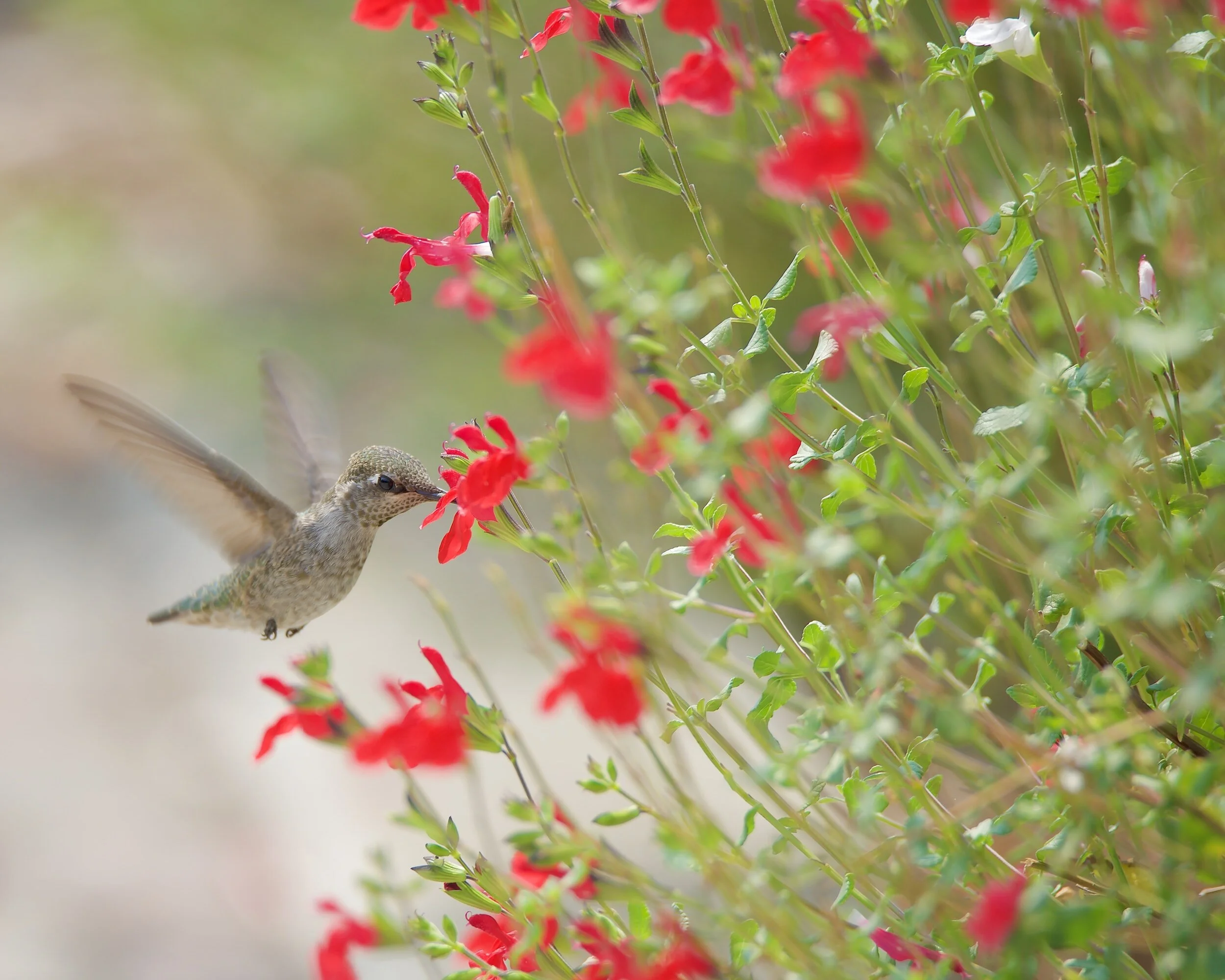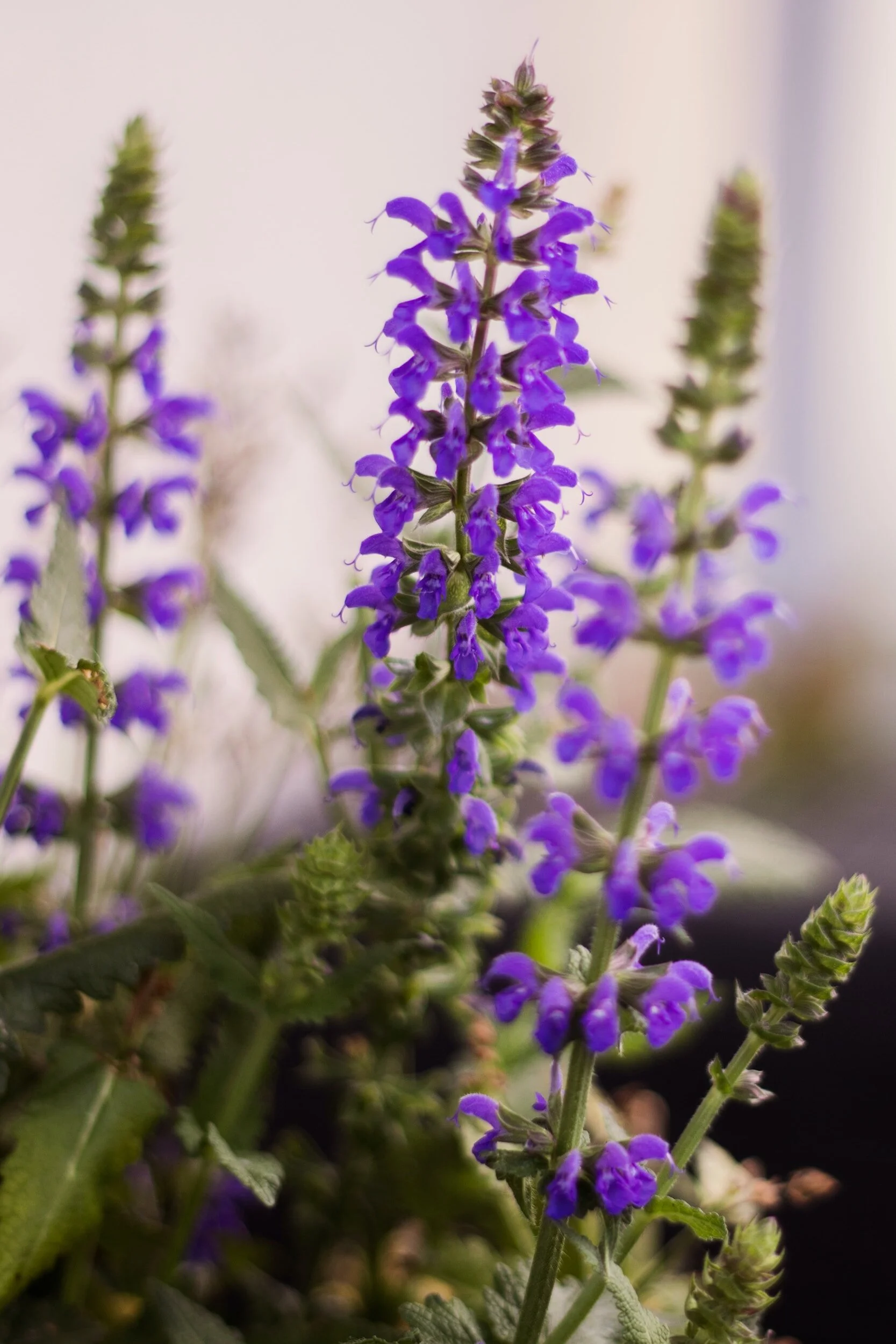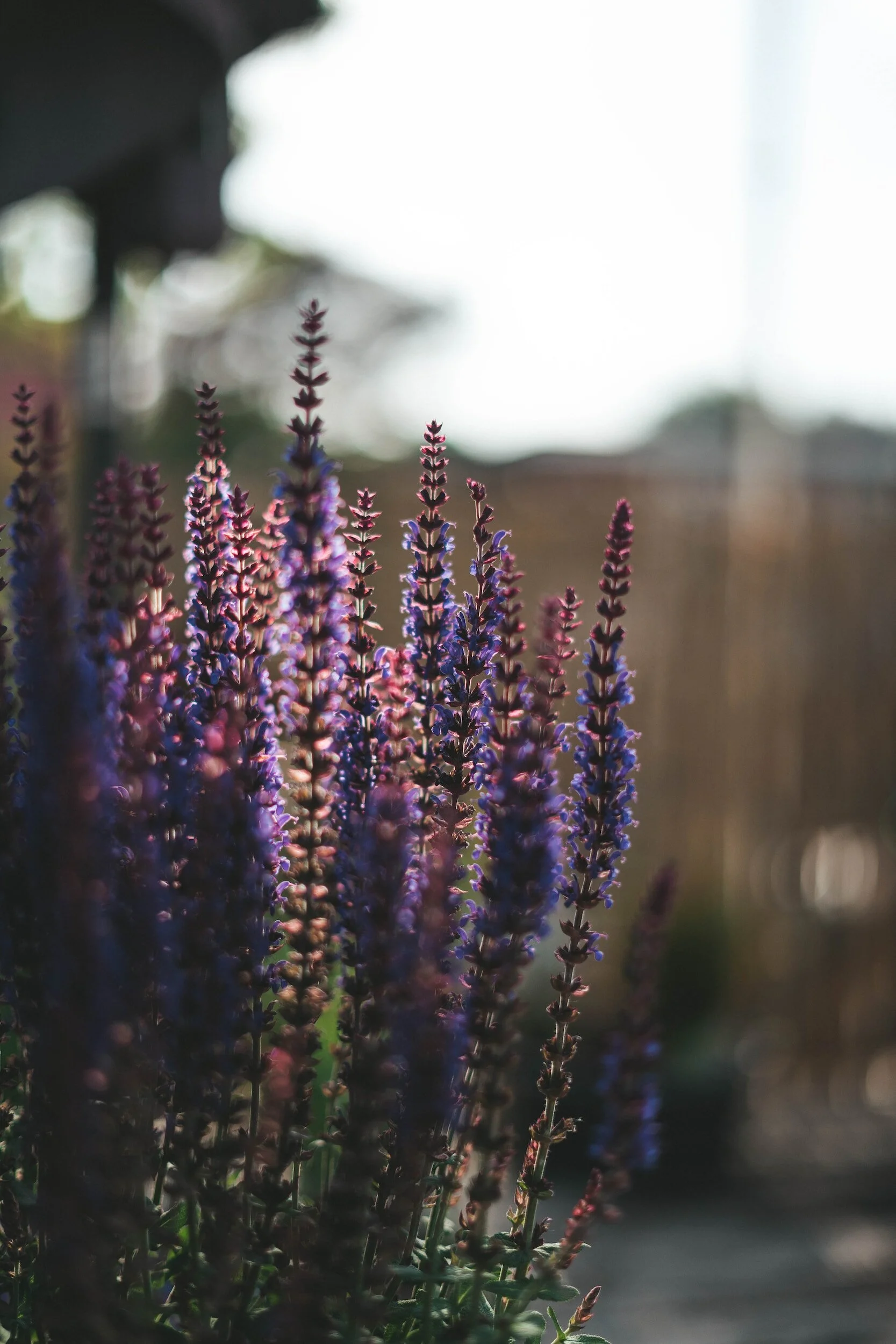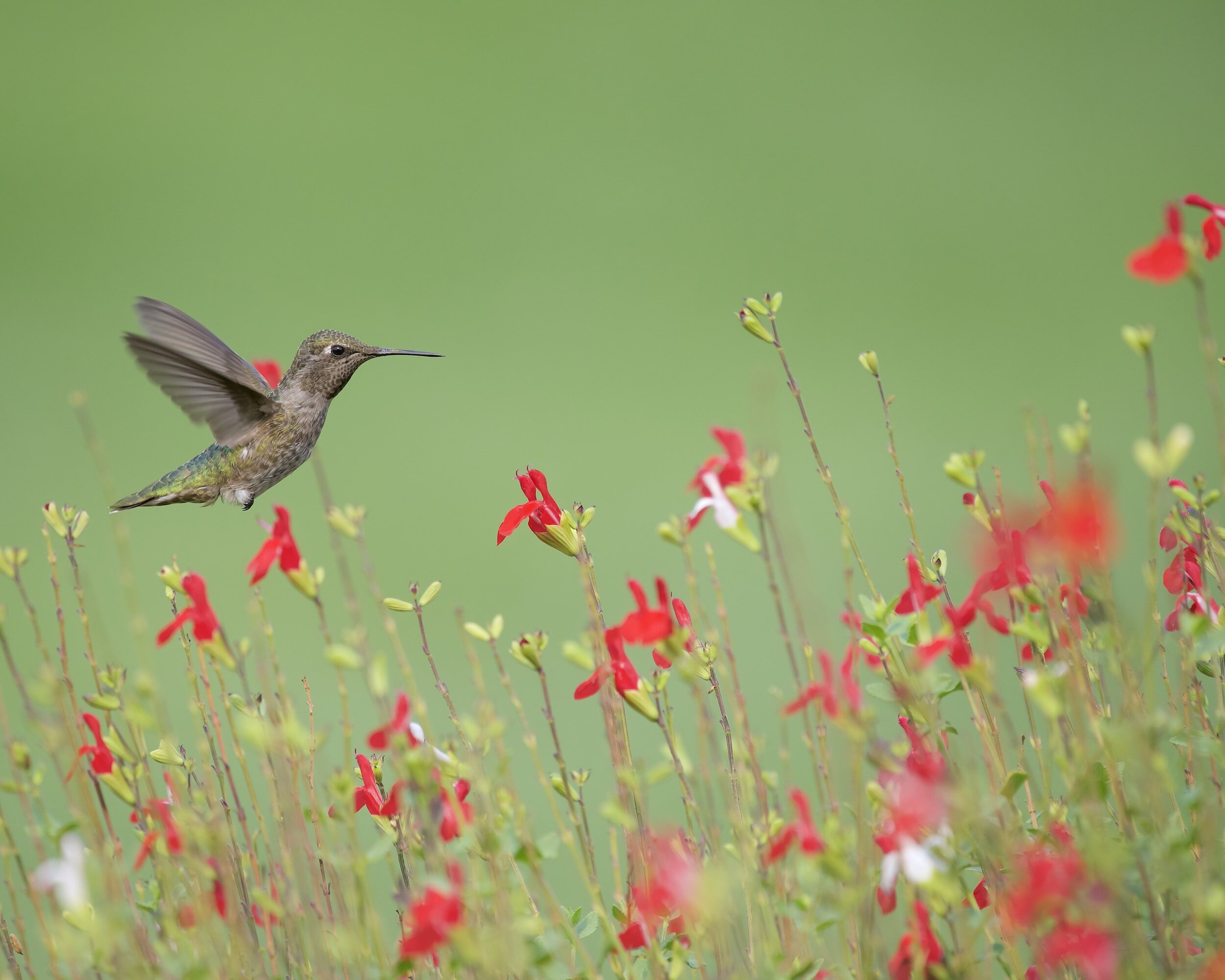Growing Vibrant Salvia in Pots
This article has links to products that I may make commission from.
If you're looking to add some color and life to your balcony or patio growing salvia in pots might just be the perfect gardening project for you.
Renowned for their vivid purple, blue, and red flowers, salvias are not only a visual delight but also relatively easy to care for.
In this guide, we'll dive into everything you need to know about nurturing these beautiful plants in containers, from selecting the right variety to ensuring they flourish in their potted environment.
Salvia plants are a fantastic choice for bringing a burst of color and nature closer to your living space.
To learn more about growing salvia, check out my guide:
Choosing the Right Salvia
When it comes to growing salvias in pots, selecting the right type is crucial for success.
Salvias are a diverse group with over 900 species, offering a range of colors, sizes, and growing habits.
Here, we'll delve deeper into understanding the key differences and which varieties are best suited for container gardening.
Perennial vs Annual Salvia
Firstly, it's important to distinguish between perennial and annual salvias.
Perennial salvias are plants that live for more than two years.
They go dormant in winter and re-sprout in spring, offering a display of new growth and blooms each year.
Examples include Salvia microphylla and Salvia greggii.
These varieties are hardy, often surviving winters in the ground, but in pots, they may require some protection.
Annual salvias, in contrast, complete their life cycle in one growing season.
They grow, flower, set seed, and die within one year.
While they need to be replanted annually, they are often more vibrant and bloom more profusely. Examples include Salvia splendens and Salvia coccinea.
Best Salvias for Pots
When selecting salvias for pots, consider the plant's mature size and growth habit.
Dwarf and compact varieties are often the best choices, as they fit comfortably in containers without becoming overcrowded.
Look for salvias that have a bushy or clumping growth habit, rather than those that spread widely or grow too tall.
Dwarf Varieties:
These are particularly suited for pots due to their compact size.
Varieties like Salvia microphylla 'Hot Lips', with its striking red and white flowers, or Salvia greggii 'Mirage' series, which comes in various colors, are excellent choices.
Here are the ones I recommend growing:
Shrubby Salvias: These salvias, like Salvia leucantha (Mexican bush sage), have a woody base and softer upper growth.
They offer a nice balance between size and manageability for container gardening.
Here is the one I recommend growing:
Flower Colors and Varieties: Salvias are renowned for their vibrant flowers.
Choose varieties based on your color preferences.
Purple salvias like 'Caradonna' are popular for their deep hues.
For a more varied palette, consider Salvia 'Wendy's Wish' for a vibrant pink.
Here are the ones I recommend growing:
Considerations for Sun and Climate
Most salvias prefer full sun, meaning at least 6-8 hours of direct sunlight per day, like that found in a south-facing or west-facing garden.
However, some varieties can tolerate partial shade.
When selecting salvias, consider your local climate and the sun exposure in your garden or home.
While most salvias are drought tolerant once established, those in pots may need more frequent watering.
Salvia Species for Special Interests
If you are interesting in attracting pollinators or creating a scented garden, certain salvia varieties can cater to these needs.
For example, Salvia 'Black and Blue' is known to attract hummingbirds, while Salvia sclarea offers a pleasant aromatic foliage.
Here are the ones I recommend:
Also, check out my guide Pruning Salvias: How to Prune for Abundant Flowers.
To learn more about growing flowers in pots, check out my guides:
Planting and Soil Requirements
Successful cultivation of salvia in pots largely depends on the right planting techniques and soil composition.
Understanding these elements will ensure your salvias thrive and produce vibrant blooms.
Soil Composition
The key to a good soil mix for salvias is drainage.
These plants prefer well-drained soil as it prevents root rot and other moisture-related issues.
For container-grown salvias, a standard potting mix can be improved by adding perlite, vermiculite, or coarse sand.
This enhances drainage and aeration, offering the roots the ideal environment to grow.
Potting Mix:
Begin with a high-quality potting mix, which typically contains a blend of pine bark.
This mix retains moisture while still allowing excess water to drain away.
Here is the potting mix I recommend for growing salvias in pots:
Amendments for Drainage:
Add perlite or coarse sand to the potting mix in a ratio of about 1:4 (one part perlite or sand to four parts potting mix).
This amendment is particularly crucial for salvias, as they are susceptible to root rot in overly wet conditions.
Here is the perlite I recommend mixing in:
Choosing the Right Pot
The choice of pot is also vital for growing salvia.
Pots made of breathable materials like terracotta or unglazed ceramic are excellent as they allow soil to dry out more evenly.
Ensure the pot has one or more drainage holes at the bottom.
Pot Size:
The size of the pot should be proportional to the size of the plant.
A pot that is too large for a small salvia can hold excess moisture, leading to root rot.
As a general rule, choose a pot that is 2 inches larger in diameter than the plant's root ball.
Here are the pots I recommend for growing salvias:
Planting Technique
When planting salvia in a pot, ensure the plant is positioned at the same depth as it was in its nursery container.
Planting too deep can cause the stem to rot, while planting too shallow can expose the roots and dry them out.
Filling the Pot:
Before placing the plant, fill the pot with a few inches of your prepared soil mix.
After placing the plant, fill around the sides with more mix, gently firming it down without compacting it too much.
Initial Watering:
After planting, water the salvia thoroughly to settle the soil around the roots.
This initial watering is crucial for eliminating air pockets and ensuring good root-to-soil contact.
Mulching and Insulation
In pots, soil can dry out quickly, especially in full sun.
Adding a layer of mulch on top of the soil can help retain moisture and regulate soil temperature.
Organic mulches like bark chips or straw are suitable for this purpose.
Here is the mulch I recommend:
Post-Planting Care
Immediately after planting, keep the soil consistently moist but not waterlogged to encourage root growth.
As the plant establishes, reduce the frequency of watering, allowing the soil to dry out slightly between watering.
For more watering tips, check out my guide How to Use Watering Globes.
Light and Temperature Requirements for Potted Salvia
Light: The Key to Vibrant Blooms
Salvias are sun-loving plants, and providing them with adequate light is crucial for their growth and flowering.
When grown in pots, it's particularly important to manage their light exposure effectively.
Sunlight Needs:
Most salvia varieties require full sun, which means they should receive at least 6 to 8 hours of direct sunlight each day.
This is essential for the plants to produce their characteristic vibrant flowers.
Positioning Pots for Optimal Light:
Place your salvia pots in a spot where they will receive ample sunlight.
South or west-facing balconies, patios, or window sills are typically ideal.
In regions with very intense sun, some afternoon shade may be beneficial, especially for lighter-colored varieties which can be prone to fading.
Indoor Considerations:
If you’re growing salvia indoors, choose the brightest spot available, usually a south-facing window.
In situations where natural light is limited, consider supplementing with grow lights to provide the necessary spectrum and intensity of light.
Temperature: Ensuring the Right Climate
Salvias are generally hardy plants, but their temperature preferences can vary based on the species and variety.
Ideal Temperature Range:
Most salvia varieties thrive in temperatures ranging from 60°F to 85°F (15°C to 29°C).
They can tolerate higher temperatures, especially if they are well-watered and have sufficient mulch to keep the roots cool.
Winter Considerations:
For perennial salvias in pots, winter temperatures can be a concern.
In regions with mild winters, the pots can stay outdoors, preferably in a sheltered location.
However, in areas with freezing temperatures, it’s advisable to bring potted salvias indoors or provide adequate protection, such as mulching the pot or moving it to a cold frame or unheated greenhouse.
Heat Tolerance and Drought Resistance:
Many salvia varieties are drought tolerant and can withstand heat well, making them ideal for warm climates.
However, potted plants lose moisture faster than those in the ground, so regular watering during hot spells is crucial.
Adjusting to Seasonal Changes
Salvias respond to seasonal changes in light and temperature.
In spring, increasing light and warmth stimulate new growth.
During summer, ensure they have adequate water and protection from extreme heat.
As fall approaches, reduce watering and prepare for winter care if necessary.
Watering and Feeding Potted Salvia
Proper watering and feeding are crucial in maintaining the health and vibrancy of salvia plants, especially when they are grown in containers.
Here we'll delve into best practices for watering and the nutritional needs of salvias in pots.
Watering: Balancing Moisture and Drainage
Frequency of Watering:
Salvias prefer a 'soak and dry' method.
Water the plants thoroughly, allowing the water to drain out of the bottom of the pot, and then wait until the top inch of soil is dry before watering again.
This frequency will vary depending on factors like temperature, humidity, and pot size.
Monitoring Soil Moisture:
Potted salvias require more frequent watering than those in the ground, as soil in containers tends to dry out faster.
Use your finger or a soil moisture meter to check the moisture level.
Seasonal Adjustments:
In hot summer months, salvias may need more frequent watering.
Conversely, in winter, especially if the plants are overwintered indoors, they require less water.
Always adjust your watering schedule based on the season and the plant’s growth stage.
Watering Technique:
When watering, aim to soak the soil without wetting the leaves too much, as this can invite fungal diseases.
Water early in the day so that any water that does get on the leaves can dry quickly in the sun.
Here is my favorite watering can for the job:
Feeding: Providing Nutrients for Growth and Blooms
Type of Fertilizer:
Use a balanced, slow-release fertilizer for salvias.
A fertilizer with equal parts nitrogen, phosphorus, and potassium (NPK) is ideal.
Here is the slow-release fertilizer I recommend:
You can also use a bloom booster fertilizer with a higher phosphorus content to encourage more flowers.
This is the best bloom booster fertilizer for salvias:
Frequency of Feeding:
Feed your salvias at the beginning of the growing season, usually in spring.
If the fertilizer is slow-release, one application may suffice for the season.
For liquid fertilizers, follow the instructions on the label, typically every 4-6 weeks.
Overwintering and Dormancy:
Reduce feeding in the fall and cease during the winter months when the plant's growth slows or stops.
Overfeeding during this period can harm the plant.
Special Considerations for Potted Salvias
Potting Mix Refreshment:
Since potted plants are confined to a limited amount of soil, nutrients get depleted faster than in garden soil.
Consider refreshing the top layer of soil each spring and repotting the plant every few years with fresh potting mix.
Avoiding Over-fertilization:
Be cautious of over-fertilizing, as this can lead to lush foliage at the expense of flowers, or even damage the plant.
If you notice signs of over-fertilization, such as salt buildup on the soil surface or leaf burn, flush the soil with water to remove excess nutrients.
Pruning and Maintenance
Proper pruning and regular maintenance are crucial for keeping your potted salvia plants healthy and vibrant.
These practices encourage robust growth, abundant flowering, and prevent pest and disease problems.
Here’s a detailed guide on how to care for your salvias through pruning and maintenance.
Pruning: Timing and Techniques
When to Prune:
The best time to prune perennial salvias is in early spring as new growth starts to appear.
This timing encourages bushy growth and abundant blooms.
For annual salvias, regular trimming throughout the growing season is beneficial.
How to Prune:
Start by removing any dead or damaged stems to promote healthy growth.
For perennial salvias, cut back about one-third to one-half of the plant's height to encourage new growth.
Make your cuts just above a set of leaves or a growth node.
To learn more about pruning salvias, check out my guide Pruning Salvias: How to Prune for Abundant Flowers.
Deadheading:
Regularly remove spent flowers (deadheading) to encourage the plant to produce more blooms.
For salvias, snip off the faded blooms along with a small portion of the stem to keep the plant looking tidy and to stimulate further flowering.
Maintenance: Keeping Salvia Healthy
Checking for Pests and Diseases:
Regularly inspect your salvias for signs of pests like aphids or diseases such as powdery mildew.
Early detection and treatment are key to managing these issues.
Soil and Mulch Check:
Periodically check the soil and mulch around your salvias.
Refresh the mulch as needed to maintain moisture and regulate soil temperature.
Ensure the soil hasn't compacted over time, which can impede drainage.
Staking and Supporting: Some taller varieties of salvia may require staking, especially when they are heavy with blooms.
Provide appropriate support to prevent the stems from breaking or leaning too much.
Here are the garden stakes I recommend using:
Overwintering Potted Salvias
Preparing for Winter:
In regions with cold winters, prepare your potted salvias for the dormant season.
If the variety is not frost-hardy, move the pots indoors to a cool, frost-free area.
Reduce watering and stop fertilizing during this period.
Winter Pruning:
Some gardeners prefer to prune salvias back in late fall or early winter to tidy up the plants.
However, leaving some growth can provide extra insulation against cold weather. Assess based on your climate and the salvia variety.
Refreshing the Plant
Repotting:
Every 2-3 years, consider repotting your salvia to refresh the soil and provide more space for growing roots.
Choose a slightly larger pot and fresh potting mix to rejuvenate the plant.
Dividing Perennials:
Perennial salvias in pots can become overcrowded over time.
Divide them in the spring every few years to maintain vigor. Replant the divisions in separate pots with fresh soil.
FAQs
How Do I Care for Salvias in Pots?
Caring for salvias in pots involves several key steps.
Firstly, ensure they are planted in well-draining soil in a pot with drainage holes to prevent waterlogging.
Salvias need full sun, so place them in a spot where they receive at least 6-8 hours of direct sunlight daily.
Water when the top inch of soil feels dry to the touch, but be cautious not to overwater.
Feed with a balanced fertilizer in early spring and prune in early spring or after the first flush of blooms to encourage more flowers.
Regularly check for pests and diseases, and take action as needed.
Can I Grow Salvias in Pots Indoors?
Yes, salvias can be successfully grown in pots indoors, provided they receive enough light.
They need bright, direct sunlight for several hours a day, so a south-facing window is ideal.
If natural light is insufficient, supplement with grow lights.
Here are the grow lights I recommend:
Maintain the same watering and feeding routine as you would for outdoor plants, but be aware that indoor conditions may alter these needs slightly.
Do Salvias Come Back Every Year?
Perennial salvias come back each year.
They die back to the ground in winter and re-sprout in spring.
Annual salvias, however, complete their life cycle in one year and do not return.
In pots, perennial salvias may need extra protection during winter, especially in colder climates.
How Do I Overwinter Salvias in Pots?
To overwinter salvias in pots, first determine if your variety is frost-hardy.
For non-hardy varieties, move the pots indoors to a cool, frost-free area before the first frost.
Reduce watering during winter but do not let the soil completely dry out.
For hardy varieties, you can leave them outdoors but consider adding a layer of mulch for insulation and moving the pot to a sheltered location.
What Are the Common Problems With Salvias?
Common problems with salvias include root rot from overwatering, powdery mildew, and pest infestations (like aphids).
Ensuring good drainage and air circulation helps prevent these issues.
How Do I Deadhead Salvias in Pots?
To deadhead salvias, use clean, sharp scissors or pruning shears to snip off the spent flower spikes just above a leaf node or a new flower bud.
Regular deadheading encourages the plant to produce more blooms and extends the flowering period.
Can I Grow Salvias From Seed?
Yes, salvias can be grown from seed.
Start seeds indoors 6-8 weeks before the last frost date or sow directly in the pot after the danger of frost has passed.
Keep in mind that some hybrid varieties may not grow true to seed.
Conclusion
Successfully growing and enjoying plant salvia in pots is a rewarding endeavor for any gardener.
Whether you are drawn to the allure of purple flowers, the serenity of blue blooms, or the vibrancy of red flowers, salvias offer a spectrum of colors to enhance your space.
The key to thriving salvia plants lies in providing well-drained soil and the right care routine.
By following the guidelines outlined in this guide, you can cultivate these beautiful flowers in your home or garden, adding a splash of color and charm with minimal effort.
Salvia, with its diverse and striking blooms, is indeed a versatile and delightful addition to any potted plant collection.
Want to learn more about growing in pots? Check out my guides:


















































